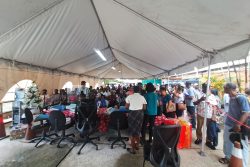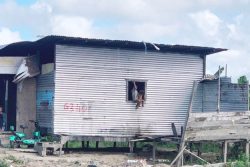SOL (Guyana) says it is losing millions of dollars annually because vessels with the capacity to carry large quantities of fuel cannot enter the heavily silted Demerara River channel while fully laden.
However, Public Works Minister, Robeson Benn, says that dredging will once again commence shortly to ease the lingering problem facing shippers through Port Georgetown.
In an interview with Stabroek News, SOL General Manager and soon to be Regional Manager of the company, Ken Figaro said the cash draining situation faced by his company was as a result of the silted Demerara river.
He indicated that the more weight that is placed in vessels, the deeper they submerge in the water. In order to sail safely and freely, without touching the bottom of the river, vessels may be forced to carry less cargo. However, the freight charges remain the same, as the reduced cargo is no fault of the shipper. Therefore with “dead freight…you pay more for less,” he said. He explained the term “dead freight” as being the difference between the maximum cargo that a vessel can carry as opposed to what it actually carries. Figaro admitted that Sol has had the dead freight problem over the years, however, the absence of the THD dredge Steve N caused the situation to worsen in 2011.
SOL has, according to the official, spent over $45 million, last year, on dredging the river at its Ramsburg and Rome terminals and the company would probably have to spend a similar sum in another few months to dredge again since the problem of silting of the channel is ongoing.
The SOL official stated that while his company has never made any direct representation to government, the problem has been aired at several forums. He added that he is aware of representation being made by the private sector and other representative groups. He further expressed the view that a clear waterway is critical to the economic development of Guyana.
Director General of the Maritime Administration (MARAD), Claudette Rogers said her entity was never told by SOL that it had been losing money and she awaits this in writing from the company.
Reacting to this latest concern about the shallowness of Guyana’s present major sea thoroughfare, the Public Works Minister said the government-owned dredge, the Steve N, is currently in dry dock being repaired and would be back in operation by mid to late February. He informed that the dredge was old and had been taking on dredging of the Demerara channel on a 24-hr hour basis hence its malfunction. He said that when it becomes operational in February shippers would see some ease in the current silting of the channel. However, dredging of the river will always be an issue because of Guyana’s geographical position and its river water type.
Benn said that he had met John Fernandes’ representative, Chris Fernandes, earlier this month and the dredging of the river to improve Guyana’s shipping industry was one of the many issues discussed.
The minister said government is proposing to add a shipping levy to the tonnage of freight brought in by companies to help offset the cost of the Steve N dredging the channel. He added that the levy would easily be recovered by businesses since they will be able to bring more cargo to supply Guyanese consumers.
“The issue of the silting of the Demerara River cannot be reversed since it is a natural given the geographical position of Guyana and the makeup of that river so what we have to do is to make the best of it and constantly dredge. It is how it always will be,” said Benn.
He recalled that Guyana’s commercial shipping sector had once benefited from the constant dredging of the channel by the Dutch company Royal Boskalis which had dredged the Demerara channel for its own bauxite business but the rewards were reaped by all shippers.





